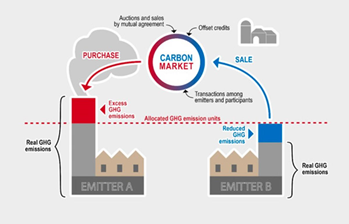

Context
Recently passed Energy Conservation (Amendment) Bill, 2022 empowers the Government to establish carbon markets in India and specify a carbon credit trading scheme.
What are carbon markets?
- To meet nationally determined contributions (NDCs), one mitigation strategy is becoming popular with several countries—carbon markets.
- Article 6 of the Paris Agreementprovides for the use of international carbon markets by countries to fulfil their NDCs.
- Carbon markets are essentially a tool for putting a price on carbon emissions— they establish trading systems where carbon credits or allowances can be bought and sold.
- A carbon credit is a kind of tradable permitthat, per United Nations standards, equals one tonne of carbon dioxide removed, reduced, or sequestered from the atmosphere.
- These markets create incentives to reduce emissions or improve energy efficiency.

Sentiments of countries about carbon markets
- About 83% of NDCs submitted by countries mention their intent to make use of international market mechanisms to reduce greenhouse gas emissions.
What are the types of carbon markets?
- There are broadly two types of carbon markets that exist today— compliance marketsand voluntary markets.
|
Voluntary Markets |
Compliance Markets |
|
Here, the Emitters— corporations, private individuals, and others— buy carbon credits to offset the emission. |
Compliance markets are set up by policies at the national, regional, and/or international levels— that is officially regulated. |
|
In voluntary markets, credits are verified by private firms as per popular standards. |
Most of these markets operate under a principle called ‘cap-and-trade”. |
|
Here the participants purchase emissions reductions for public relations or personal reasons. |
Here the carbon offsets are created by the need to comply with a regulatory act |
|
Examples of compliance carbon markets are the:
|
|
Cap-and-Trade vs Carbon Tax
|
Advantages:
|
Related Indian Initiatives
|
- These markets may promote the reduction of energy use and encourage the shift to cleaner fuels.
- Through this kind of carbon trading, companies can decide if it is more cost-efficient to employ clean energy technologies or to purchase additional allowances.
- Since government-regulated trading schemes may prompt companies to innovate, invest in, and adopt cost-efficient low-carbon technologies.
What are the challenges to carbon markets?
- Effectiveness of carbon markets: Some companies simply buy credits without making any effort to reduce emissions themselves.
- It is cheaper for them to buy carbon credit than to invest in emission-reducing technologies.
- Environmental activists argue that only high-quality carbon offsets are effective in reducing emissions. High-quality carbon offsets have certain features:
- Additionality:Emission reductions must be additional i.e., they would not have occurred in the absence of a market for offset credits e.g., a renewable project could be set up only because a high emitter paid for it.
- Verifiable: There must be proper audits to ensure the monitoring, reporting, and verification of emission cuts.
- Permanence:The emission reduction should not be reversed.
- However, many credits available in markets are of poor quality i.e., they do not meet the above criteria.
- Buying carbon credits can deviate rich nationsfrom the path of reducing emissions.
- It is difficult to establish the amount of carbon reduced by offset projects(like afforestation or wind energy project).

